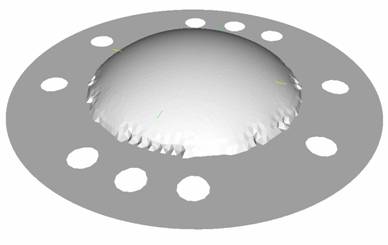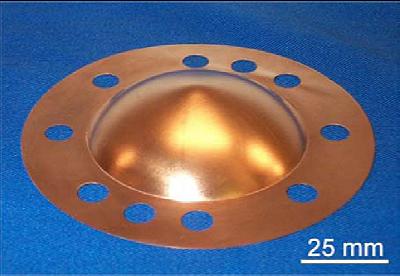Plastic deformation of thin copper plates from water hammer
The simulations on this page try to reproduce experimental results provided by V.S. Deshpande, University Cambridge. A strong pressure wave in water is created by firing a steel projectile on a piston at the end of the tube. The wave propagates through the tube and impinges onto a thin copper plate sealing the other end. Depending on the initial projectile velocity the pressure induces plastic deformation of different rupture patterns.
The experimental facility is described in debth in V.S. Deshpande, A. Heaver, N.A. Fleck, An underwater shock simulator. Royal Society of London Proceedings Series A, 462(2067):1021-1041, 2006.
Basic computational setup
Fluid
- Pressure wave generated by solving equation of motion for piston during entire fluid-structure simulation.
- Full water shock tube of 1.3m length, 64mm diameter considered in fluid. 1d simulations used to provide proper flow field for coupled 3d simulations.
- Modeling of water with stiffened gas equation of state with %$\gamma=7.415, p_\infty=296.2\,\rm MPa$%
- Multi-dimensional 2nd order upwind finite volume scheme, negative pressures from cavitation avoided by energy correction
- AMR base level: 350x20x20, 2 additional levels, refinement factor 2,2.
- Approx. 1,2M cells used in fluid on average instead of 9M (uniform)
Solid with SFC
- Copper plate of 0.25mm, J2 plasticity model with hardening, rate sensitivity, and thermal softening
- Solid mesh: 4675 nodes, 8896 elements
- 8 nodes 3.4 GHz Intel Xeon dual processor, Gigabit ethernet network, ca. 130h CPU to t=1ms
More details can be found in F. Cirak, R. Deiterding, S.P. Mauch, Large-scale fluid-structure interaction simulation of viscoplastic and fracturing thin shells subjected to shocks and detonations, Computer & Structures 85 (11-14): 1049-1065, 2006.
Plastic material deformation
- For a peak pressure of p0=34MPa the material deformation is plastic. No rupture occurs.
- The purely plastic simulation uses a signed distance function and considers the fluid loading inside the tube. A constant atmosphaeric pressure of 1bar is subtracted from the interior loading.
- Movies are available to visualize the wave impact and the plate deformation:
- Source codes: [fluid codes] [solid codes]
Comparison of plate for p0=34MPa at the end of the simulation (1ms simulated) and after the experiment:


Parallel performance
| Task | F=6, S=2 | F=12, S=4 | F=24, S=8 | F=48, S=16 | F=96, S=32 |
| s | % | s | % | s | % | s | % | s | % |
| Integration | 1246 | 27.3 | 628 | 22.4 | 349 | 16.1 | 183 | 12.5 | 83 | 8.8 |
| Boundary sync | 1884 | 41.3 | 1113 | 39.6 | 1044 | 48.1 | 735 | 50.1 | 447 | 47.3 |
| Recomposition | 152 | 3.3 | 154 | 5.5 | 138 | 6.4 | 124 | 8.5 | 98 | 10.4 |
| Interpolation | 46 | 1.0 | 27 | 1.0 | 15 | 0.7 | 8 | 0.5 | 4 | 0.4 |
| Regridding | 33 | 0.7 | 24 | 0.9 | 13 | 0.6 | 6 | 0.4 | 4 | 0.4 |
| GFM Find cells | 144 | 3.2 | 76 | 2.7 | 43 | 2.0 | 23 | 1.6 | 11 | 1.2 |
| GFM Interpolation | 458 | 10.0 | 242 | 8.6 | 133 | 6.1 | 69 | 4.7 | 33 | 3.5 |
| GFM Overhead | 72 | 1.6 | 21 | 0.7 | 6 | 0.3 | 7 | 0.5 | 3 | 0.3 |
| CPT | 22 | 0.5 | 17 | 0.6 | 15 | 0.7 | 13 | 0.9 | 12 | 1.3 |
| Level set sync | 119 | 2.6 | 206 | 7.3 | 187 | 8.6 | 134 | 9.1 | 107 | 11.3 |
| ELC | 260 | 5.7 | 208 | 7.4 | 165 | 7.6 | 117 | 8.0 | 102 | 10.8 |
| Coupling data calc | 25 | 0.5 | 9 | 0.3 | 6 | 0.3 | 4 | 0.3 | 2 | 0.2 |
| Misc | 105 | 2.3 | 84 | 3.0 | 55 | 2.5 | 43 | 2.9 | 39 | 4.1 |
| Total | 4566 | | 2809 | | 2169 | | 1466 | | 945 | |
F denotes the number of CPUs for the fluid solver, S the number of CPUs for the solid solver.
--
RalfDeiterding - 12 Feb 2007


